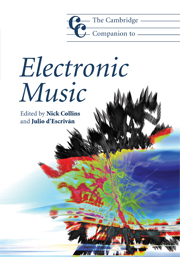3 - Live electronic music
from Part I - Electronic music in context
Published online by Cambridge University Press: 28 September 2011
Summary
It is perhaps a general human habit to view the technological and the organic as opposites. It is certainly the case that the phrase ‘live electronic music’ strikes many a music fan as oxymoronic. Isn't the purpose of electronics to do things for us so we don't have to do them ‘live’ ourselves? To record, perfect and play back performances so we can listen while cycling stationarily? To facilitate the creation of inhumanly intricate compositions that spew themselves out of speakers at the touch of a button, instead of all that messy sliding about on strings? While there is no question that composers of tape music and computer music (and a fair number of pop music producers as well) have employed electronics to exactly these ends, electronic technology has another, and possibly more profound power: enabling new and volatile connections. Don't think Edison, think Alexander Graham Bell. Since the 1930s (well before the advent of tape) composers have been using this property of electronics to produce not just new sounds but fundamentally new approaches to organising the sonic world.
Pre-history
Electronic music has its pre-history in the age of steam. In 1897 Thaddeus Cahill patented the Telharmonium, a machine that weighed in at over two hundred tons and resembled a power station more than a musical instrument. It generated sine tones with dynamos, played from an organ-like keyboard. Cahill understood that electricity could provide not only sound but a means of distribution as well: the Telharmonium's sounds were carried over the telephone lines that were beginning to be laid in major cities, intended for playback through speaker systems in restaurants, hotel lobbies and homes of the rich. Cahill envisaged a subscription-based music service, not unlike that of the Muzak corporation thirty-seven years later, but unlike pre-recorded Muzak, the Telharmonium was an instrument that had to be played to be heard.
- Type
- Chapter
- Information
- The Cambridge Companion to Electronic Music , pp. 38 - 54Publisher: Cambridge University PressPrint publication year: 2007
- 6
- Cited by

